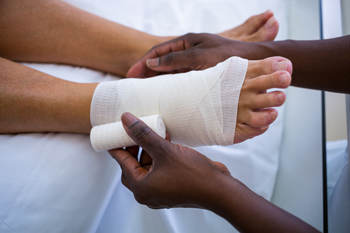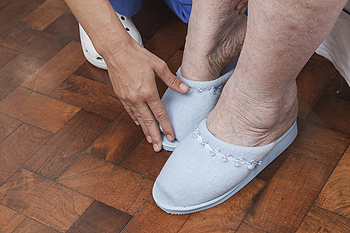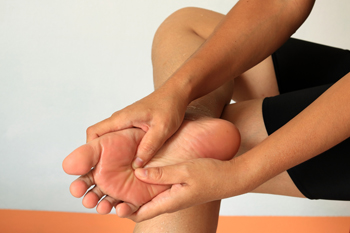
 Foot wound prevention and care can be slightly more difficult during the cold winter season than during the rest of the year. A common cause of foot wounds in the wintertime is, perhaps ironically, excessive heat. When trying to warm up during the winter, you may not notice excess heat from a hot bath or space heater potentially burning your feet, especially if you have reduced sensation due to conditions like diabetes. Another culprit of foot wounds in the wintertime is dry skin. The cold winter air can make the skin of the feet dry and more likely to crack, thereby increasing the risk of developing foot wounds. It is important to monitor the health of your feet in the winter and all year round, checking regularly for any cuts, scrapes, sores, or other abnormalities. If you notice any changes in your feet, please consult with a podiatrist.
Foot wound prevention and care can be slightly more difficult during the cold winter season than during the rest of the year. A common cause of foot wounds in the wintertime is, perhaps ironically, excessive heat. When trying to warm up during the winter, you may not notice excess heat from a hot bath or space heater potentially burning your feet, especially if you have reduced sensation due to conditions like diabetes. Another culprit of foot wounds in the wintertime is dry skin. The cold winter air can make the skin of the feet dry and more likely to crack, thereby increasing the risk of developing foot wounds. It is important to monitor the health of your feet in the winter and all year round, checking regularly for any cuts, scrapes, sores, or other abnormalities. If you notice any changes in your feet, please consult with a podiatrist.
Wound care is an important part in dealing with diabetes. If you have diabetes and a foot wound or would like more information about wound care for diabetics, consult with one of our podiatrists from Grand Blanc Family Footcare. Our doctors will assess your condition and provide you with quality foot and ankle treatment.
What Is Wound Care?
Wound care is the practice of taking proper care of a wound. This can range from the smallest to the largest of wounds. While everyone can benefit from proper wound care, it is much more important for diabetics. Diabetics often suffer from poor blood circulation which causes wounds to heal much slower than they would in a non-diabetic.
What Is the Importance of Wound Care?
While it may not seem apparent with small ulcers on the foot, for diabetics, any size ulcer can become infected. Diabetics often also suffer from neuropathy, or nerve loss. This means they might not even feel when they have an ulcer on their foot. If the wound becomes severely infected, amputation may be necessary. Therefore, it is of the upmost importance to properly care for any and all foot wounds.
How to Care for Wounds
The best way to care for foot wounds is to prevent them. For diabetics, this means daily inspections of the feet for any signs of abnormalities or ulcers. It is also recommended to see a podiatrist several times a year for a foot inspection. If you do have an ulcer, run the wound under water to clear dirt from the wound; then apply antibiotic ointment to the wound and cover with a bandage. Bandages should be changed daily and keeping pressure off the wound is smart. It is advised to see a podiatrist, who can keep an eye on it.
If you have any questions, please feel free to contact our office located in Grand Blanc, MI . We offer the newest diagnostic and treatment technologies for all your foot care needs.
 Falling episodes among elderly people is a common occurrence worldwide. Many patients' feet are affected, and may endure a broken foot or sprained ankle as a result of an unexpected fall. Effective prevention techniques can consist of improving lighting in the household and getting regular physical examinations. Maintaining correct medications which may affect your vision can also reduce the risk of falling. Additionally, many patients find it is beneficial to install grab bars in the shower and toilet area, as this provides the necessary stability that can help to prevent falling. If you or a loved one is concerned about how falling can affect the feet, it is suggested that you speak with a podiatrist who can help you with proper prevention techniques.
Falling episodes among elderly people is a common occurrence worldwide. Many patients' feet are affected, and may endure a broken foot or sprained ankle as a result of an unexpected fall. Effective prevention techniques can consist of improving lighting in the household and getting regular physical examinations. Maintaining correct medications which may affect your vision can also reduce the risk of falling. Additionally, many patients find it is beneficial to install grab bars in the shower and toilet area, as this provides the necessary stability that can help to prevent falling. If you or a loved one is concerned about how falling can affect the feet, it is suggested that you speak with a podiatrist who can help you with proper prevention techniques.
Preventing falls among the elderly is very important. If you are older and have fallen or fear that you are prone to falling, consult with one of our podiatrists from Grand Blanc Family Footcare. Our doctors will assess your condition and provide you with quality advice and care.
Every 11 seconds, an elderly American is being treated in an emergency room for a fall related injury. Falls are the leading cause of head and hip injuries for those 65 and older. Due to decreases in strength, balance, senses, and lack of awareness, elderly persons are very susceptible to falling. Thankfully, there are a number of things older persons can do to prevent falls.
How to Prevent Falls
Some effective methods that older persons can do to prevent falls include:
Falling can be a traumatic and embarrassing experience for elderly persons; this can make them less willing to leave the house, and less willing to talk to someone about their fears of falling. Doing such things, however, will increase the likelihood of tripping or losing one’s balance. Knowing the causes of falling and how to prevent them is the best way to mitigate the risk of serious injury.
If you have any questions, please feel free to contact our office located in Grand Blanc, MI . We offer the newest diagnostic and treatment technologies for all your foot care needs.
 Morton’s neuroma occurs when the nerves in the foot become inflamed. Usually, the nerves that are affected are in the ball of the foot between the 3rd and 4th toes. Signs of Morton’s neuroma include a sharp burning sensation, a lack of feeling, or a tingling in the forefoot area. These symptoms usually show up when pressure is placed on the foot during activities such as walking, standing, running or jumping. Most commonly, Morton’s neuroma is caused by a foot deformity that causes the foot bones to squeeze the nerves. Because of this, footwear that squeezes and constricts the toes can often lead to a neuroma, and a shoe with a wide toe box is suggested for decreasing foot pain. Morton’s neuroma can be treated by a podiatrist. Treatment options that your podiatrist may recommend include orthotics, cortisone injections and, in severe cases, surgery.
Morton’s neuroma occurs when the nerves in the foot become inflamed. Usually, the nerves that are affected are in the ball of the foot between the 3rd and 4th toes. Signs of Morton’s neuroma include a sharp burning sensation, a lack of feeling, or a tingling in the forefoot area. These symptoms usually show up when pressure is placed on the foot during activities such as walking, standing, running or jumping. Most commonly, Morton’s neuroma is caused by a foot deformity that causes the foot bones to squeeze the nerves. Because of this, footwear that squeezes and constricts the toes can often lead to a neuroma, and a shoe with a wide toe box is suggested for decreasing foot pain. Morton’s neuroma can be treated by a podiatrist. Treatment options that your podiatrist may recommend include orthotics, cortisone injections and, in severe cases, surgery.
Morton’s neuroma is a very uncomfortable condition to live with. If you think you have Morton’s neuroma, contact one of our podiatrists of Grand Blanc Family Footcare. Our doctors will attend to all of your foot care needs and answer any of your related questions.
Morton’s Neuroma
Morton's neuroma is a painful foot condition that commonly affects the areas between the second and third or third and fourth toe, although other areas of the foot are also susceptible. Morton’s neuroma is caused by an inflamed nerve in the foot that is being squeezed and aggravated by surrounding bones.
What Increases the Chances of Having Morton’s Neuroma?
Morton’s neuroma is a very treatable condition. Orthotics and shoe inserts can often be used to alleviate the pain on the forefront of the feet. In more severe cases, corticosteroids can also be prescribed. In order to figure out the best treatment for your neuroma, it’s recommended to seek the care of a podiatrist who can diagnose your condition and provide different treatment options.
If you have any questions, please feel free to contact our office located in Grand Blanc, MI . We offer the newest diagnostic and treatment technologies for all your foot care needs.
 A Jones fracture occurs at the base of the foot near the little toe when the midsection of the 5th metatarsal bone is broken. This type of injury is rather common among basketball players. A Jones fracture is typically the result of stress on the bone rather than contact, but if left untreated, pain and swelling can occur. Due to limited blood flow in the affected area, this injury may take longer to heal and has a greater possibility of refracture. In order to limit the chance of refracture, surgery is generally the most recommended treatment option. The surgery involves placing a screw into the foot to stabilize the area around the injury and minimize the amount of time required for immobilization. A Jones fracture usually takes six to eight weeks to heal completely. If you believe that you suffered a Jones fracture while playing basketball or any other sport, it is important to have it checked by a podiatrist for proper care and treatment.
A Jones fracture occurs at the base of the foot near the little toe when the midsection of the 5th metatarsal bone is broken. This type of injury is rather common among basketball players. A Jones fracture is typically the result of stress on the bone rather than contact, but if left untreated, pain and swelling can occur. Due to limited blood flow in the affected area, this injury may take longer to heal and has a greater possibility of refracture. In order to limit the chance of refracture, surgery is generally the most recommended treatment option. The surgery involves placing a screw into the foot to stabilize the area around the injury and minimize the amount of time required for immobilization. A Jones fracture usually takes six to eight weeks to heal completely. If you believe that you suffered a Jones fracture while playing basketball or any other sport, it is important to have it checked by a podiatrist for proper care and treatment.
Sports related foot and ankle injuries require proper treatment before players can go back to their regular routines. For more information, contact one of our podiatrists of Grand Blanc Family Footcare. Our doctors can provide the care you need to keep you pain-free and on your feet.
Sports Related Foot and Ankle Injuries
Foot and ankle injuries are a common occurrence when it comes to athletes of any sport. While many athletes dismiss the initial aches and pains, the truth is that ignoring potential foot and ankle injuries can lead to serious problems. As athletes continue to place pressure and strain the area further, a mild injury can turn into something as serious as a rupture and may lead to a permanent disability. There are many factors that contribute to sports related foot and ankle injuries, which include failure to warm up properly, not providing support or wearing bad footwear. Common injuries and conditions athletes face, including:
Sports related injuries are commonly treated using the RICE method. This includes rest, applying ice to the injured area, compression and elevating the ankle. More serious sprains and injuries may require surgery, which could include arthroscopic and reconstructive surgery. Rehabilitation and therapy may also be required in order to get any recovering athlete to become fully functional again. Any unusual aches and pains an athlete sustains must be evaluated by a licensed, reputable medical professional.
If you have any questions please feel free to contact our office located in Grand Blanc, MI . We offer the newest diagnostic and treatment technologies for all your foot and ankle needs.